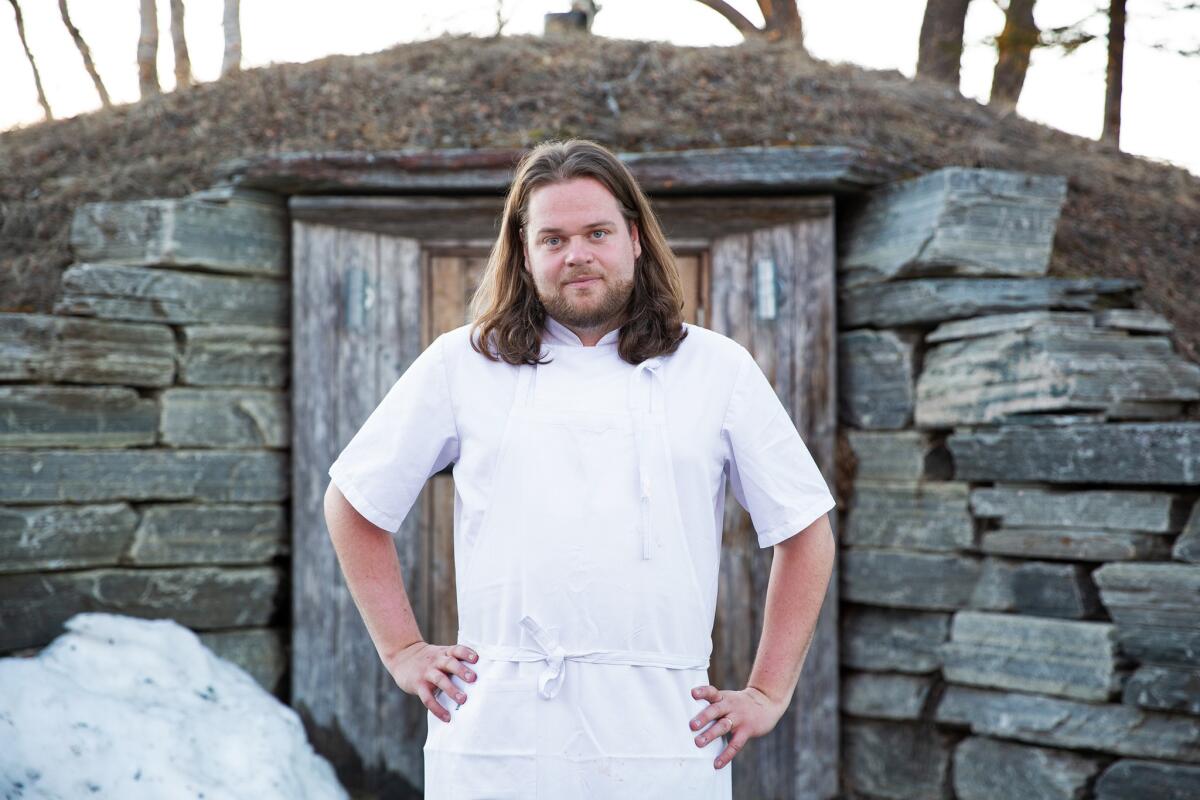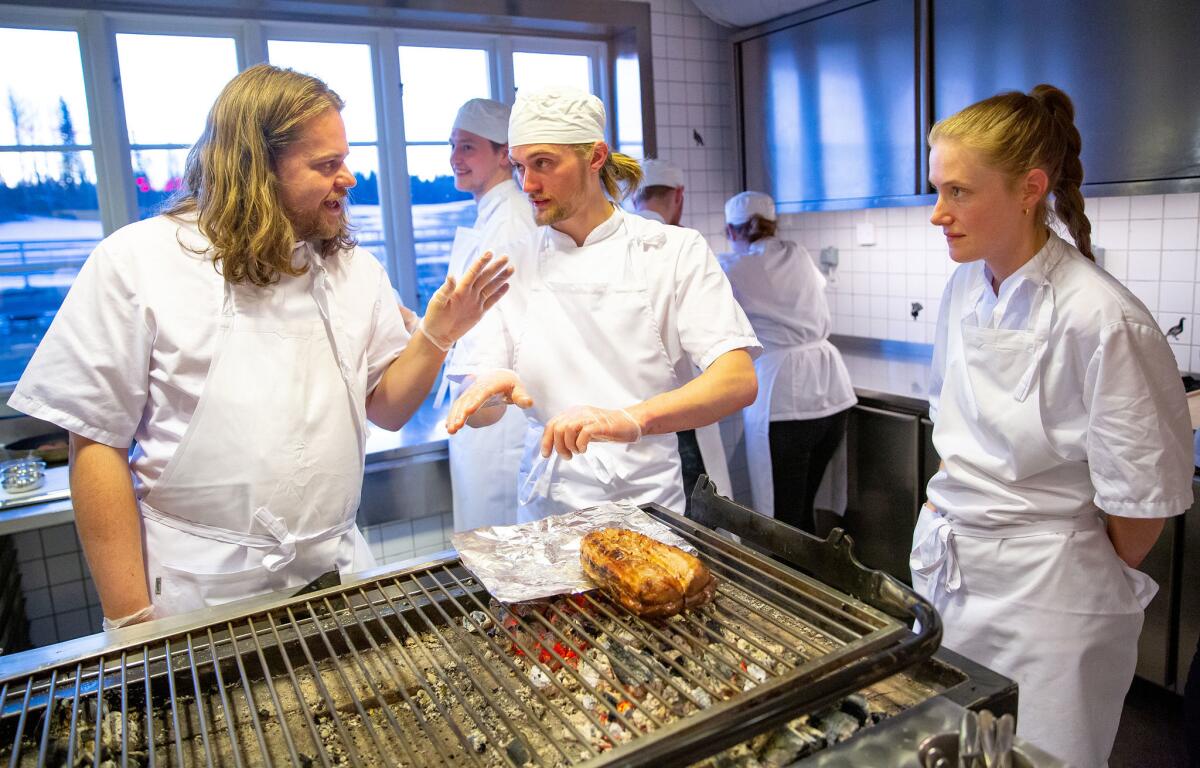The story behind why Magnus Nilsson is closing Fäviken

Sweden’s Fäviken has been recognized as one of the world’s most memorable culinary experiences for more than a decade. Chef Magnus Nilsson explains why he’s closing his 24-seat restaurant in December. (Robert Gourley / Los Angeles Times)
- Share via
Reporting from Järpen, Sweden — Magnus Nilsson is sitting in the April sun looking out at the garden at Fäviken, his 24-seat restaurant in Jämtland, in central Sweden. The snow is melting fast and the garden, one of two that supplies about half of the restaurant’s produce, is a network of browns and grays. But the garden he’s talking to me about, as we survey the approach of spring, is an 18-hectare (about 44-acre) apple orchard in southern Sweden that he and his wife, Tove, bought last fall. That’s where his mind has been lately, and where his considerable energy and curiosity will be planted soon, full time, after he closes his 11-year-old world-class restaurant for good in December.
“In every strategic way, this is not a wise decision,” says Nilsson. “But what’s the reason that someone runs a restaurant like Fäviken? Because you want to; it’s entirely driven by passion.” He says that the singular focus he has had, an effort that transformed an 18th century grain storage house into a restaurant that has routinely been numbered among the best in the world, has left him. “For the first time ever, I woke up and didn’t want to go to work.”
Fäviken and its 30-course tasting menu were chronicled in the first season of “Chef’s Table” and Nilsson was one of the chefs featured in Anthony Bourdain’s “Mind of a Chef.” Nilsson has written three cookbooks, including “The Nordic Cookbook,” a home cooking encyclopedia the size of the King James Bible that he researched, wrote and photographed himself. It’s easy to forget that he’s only 35 years old, and that Fäviken was his first try at running a restaurant.
“I’ve always known that Fäviken was not going to be forever,” he says, looking out over a small herd of red deer on a nearby field, toward snow-covered Areskutan mountain, which is on the other side of the ski resort town where he went to cooking school as a teenager. “That’s not really a revelation, because it applies to all restaurants and all businesses and really everything.”
Nilsson initially came to Jämtland to help run the wine program at the Fäviken estate and the restaurant after befriending owners Patrik and Ann-Charlotte Brummer. He’d quit cooking at 24 and moved back to Sweden after three years working in Paris, with hopes of becoming a wine writer. At that time, the Fäviken restaurant was known for making moose fondue for crowds. “My first service here was for 178 people,” says Nilsson. “It was extremely popular.”

‘I’m not leaving because I’m discontent with the restaurant. I’m just leaving because I’m done with it. Because I want to do other things.’
— Chef Magnus Nilsson
What is the lifespan of a restaurant? Particularly one knitted from the local produce and wildlife, and to a charismatic, ambitious and perpetually inquisitive chef?
“It’s a paradox of aptitude,” says Nilsson. He’s in the restaurant kitchen about three nights a week now, but he says he cooks for his family almost every day. “You’re very good at something and very quickly you find yourself doing it less and less.”
Normally restaurants close because a lease ends, or a partnership ends, or the chef leaves to open another restaurant — none of which is the case with Fäviken. Nilsson acknowledges that he could cede the running of Fäviken to his extremely talented staff, who now number 40, many of whom have been with him for years. But since the beginning, Fäviken has been an intensely personal project, an extension of the particular curiosity patterns of its chef, who grew up in nearby Östersund, and who hunts, forages, preserves and plants much of the menu himself.
“I’m not leaving because I’m discontent with the restaurant. I’m just leaving because I’m done with it. Because I want to do other things.” But, he says, “I don’t want to hand it over and write an autobiography.”
So Nilsson is engineering the end of his restaurant with the same kind of precision that he runs his kitchen. He purposefully waited to announce the closing until Fäviken was fully booked for the rest of the year — reservations were open on April 1, and filled up within hours — because he didn’t want the remaining months to operate like a wake, with diners coming to mourn or to gawk. “You don’t want people to be all crazy.” For years, he’s gone on book tours and publicized the restaurant in order to fill his tables. Now, he says, “we don’t have anything to sell.”
Later that evening, as guests have filled the tables on the second floor of the wooden farmhouse, Nilsson directs service in the immaculate white kitchen. There’s a digital countdown clock on the wall, a whiteboard with the menu and notes for the post-dinner staff meeting. At the center of the room is a stove where the crew tends a birch charcoal fire and readies trays of scallops that will be plated on a bed of faintly smoking juniper branches. For the next few hours, Nilsson and his chefs will accelerate and decelerate, controlling the pace of the dinner to the minute.

A saddle of veal is cranked over the flames like a car’s chassis. Giant grilled oysters are cut deftly in half, then bestowed upon dishes circled with nested mussel shells like jewelry. An intricate dish of lupin bean tofu fills tiny bowls. Outside the panoramic kitchen windows, the trees are turning black under a darkening sky as sparks fly up from the charcoal against the jagged horizon. As the menu shifts to smaller, faster, sweeter dishes, Nilsson fashions tiny, golden snowmen from potato cookies and caramel. “This is the retirement plan,” he says with a smile before popping one into his mouth.
The dinner is brought to a conclusion by a procession of tiny plates, tea and coffee and bottles of house-fermented spirits as guests sit in cozy chairs before the downstairs fire. The first floor great room is decorated with dried grains; saws hang like artwork on the walls, as does a wolfskin fur coat, as if some century-old woodsman hung it up and forgot it. A fire crackles in a massive tepee out in the yard, where guests can sit and smoke in sheepskin-lined wooden chairs.
The after-dinner meeting held, the kitchen is washed down for the next morning’s breakfast. Nilsson has gone home to check on his kids — he and Tove, who is working on a master’s in clinical psychology, have four children under the age of 12.
Until Dec. 14, the restaurant will operate like this, filling the six rooms upstairs for diners who stay overnight, and ushering through guests for an evening of Nilsson’s intricate translation of the region’s cooking and bounty. The gardens will be planted and picked, the bakery and butchery in one of the buildings next door to the restaurant will continue to operate. And then, just before Christmas, they will put out the fires for good and dismantle the operation. Until then, Nilsson says, he will be focused on the restaurant, not elegies or explanations.
“When it comes to the space and its future, the only thing that is for sure is that we will never run a restaurant without Magnus at Fäviken,” Patrik Brummer wrote me in an email.
Closing the restaurant, Nilsson admits, is a “very selfish decision.” He thinks of Fäviken as the result of a particular set of circumstances that had to do with the people who came together to make a unique restaurant possible in the first place. It never ran on auto-pilot and he shudders at the idea of it turning into a museum.
Instead, he is looking forward to cooking through the central Swedish seasons one last time, and taking his time away from the restaurant to be with his family and continue to work on his new fruit orchard — that’s been largely unchanged since it was replanted with old varieties of apples and pears after World War II — down south.
Nilsson says he’ll plant more trees and intern with other gardeners to learn more about the craft. “I’m not exactly sure how it’s going to pay for itself,” he says of what he’s decided to do next.
“Worst case, I’ll take a job somewhere.” Imagine.
Instagram: @AScattergood
More to Read
Eat your way across L.A.
Get our weekly Tasting Notes newsletter for reviews, news and more.
You may occasionally receive promotional content from the Los Angeles Times.











